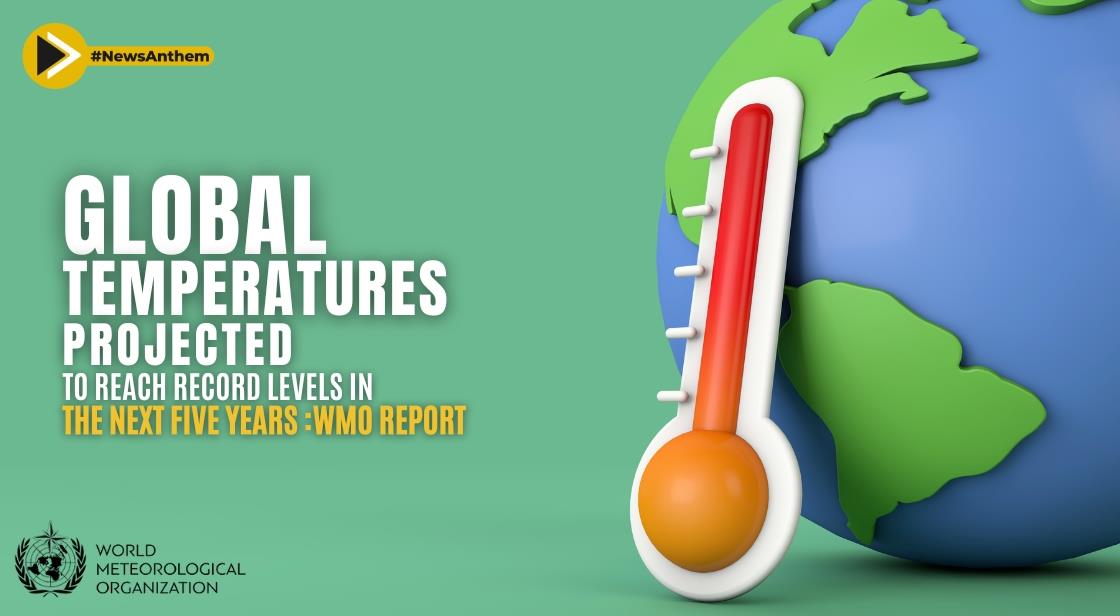Global Temperatures Projected to Reach Record Levels in the Next Five Years :WMO Report

News Synopsis
WMO Report Indicates Impending Record-Breaking Global Temperatures
Global temperatures are expected to soar to unprecedented levels in the next five years, driven by both human-induced greenhouse gas emissions and the natural occurrence of El Niño, according to a report by the World Meteorological Organisation (WMO). The WMO, a climate tracking agency supported by the United Nations, estimates a 66% likelihood that the annual average near-surface global temperature between 2023 and 2027 will exceed 1.5°C above pre-industrial levels for at least one year. Furthermore, the report reveals a staggering 98% likelihood that at least one of the next five years, as well as the five-year period as a whole, will set new records as the warmest on record.
Temporary Exceedance of the 1.5°C Threshold Raises Concerns
It is important to note that the WMO report does not imply a permanent breach of the 1.5°C threshold specified in the Paris Agreement, which refers to long-term warming trends. However, the WMO emphasizes the urgent need for concern as the frequency of temporary breaches of the 1.5°C level is expected to increase. WMO Secretary-General Petteri Taalas clarifies that these temporary breaches will occur more frequently, sounding the alarm for the potential consequences on health, food security, water management, and the environment. While the cooling influence of La Niña has temporarily suppressed the longer-term warming trend over the past three years, the report warns that the recent end of La Niña and the forecasted development of a warming El Niño in the coming months will contribute to pushing global temperatures into uncharted territory.
Met Office's Climate Update Provides Additional Insights
The United Kingdom's Met Office, the WMO lead centre for climate predictions, offers further analysis through its Global Annual to Decadal Climate Update. According to their assessment, there is a 32% chance that the five-year mean global temperature will surpass the 1.5°C threshold. While this probability remains relatively low, the report highlights that the chance of temporarily exceeding the 1.5°C level has steadily increased from nearly zero in 2015 to 10% for the years between 2017 and 2021.
Implications and Consequences
The projected increase in global temperatures carries profound implications for various aspects of our planet. In addition to surpassing historical records, human-induced greenhouse gas emissions contribute to ocean heating, acidification, sea ice and glacier melt, rising sea levels, and more extreme weather events. Moreover, the report highlights the disproportionately high warming in the Arctic region, with temperature anomalies predicted to be over three times larger than the 1991-2020 average during the upcoming five extended northern hemisphere winters. Furthermore, shifts in rainfall patterns are anticipated, with increased rainfall expected in the Sahel, northern Europe, Alaska, and northern Siberia, while reduced rainfall is predicted for the Amazon
Warming Trend Expected to Continue
The WMO report released ahead of the May 22-June 2 World Meteorological Congress said that the cooling influence of La Niña-cooler-than-usual Pacific waters-over much of the past three years temporarily reined in the longer-term warming trend. However, La Niña ended in March 2023, and an El Niño-warmer than usual surface Pacific temperate-is forecast to develop in the coming months. "Typically, El Niño increases global temperatures in the year after it develops-in this case, this would be 2024, the report said.
Increasing Risk of Extreme Weather
In addition to increasing global temperatures, human-induced greenhouse gases are leading to more ocean heating and acidification, sea ice and glacier melt, sea level rise, and more extreme weather. The WMO report said that the frequency and intensity of heat waves, heavy precipitation events, droughts, and wildfires are expected to increase in the coming years.
Other Key Highlights
-
The annual mean global near-surface temperature for each year between 2023 and 2027 is predicted to be between 1.1°C and 1.8°C higher than the pre-industrial average of 1850-1900.
-
Arctic warming is disproportionately high. Over the 1991-2020 average, the temperature anomaly is predicted to be more than three times as large over the next five extended northern hemisphere winters.
-
Increased rainfall expected in the Sahel, northern Europe, Alaska, and northern Siberia, and reduced rainfall for this season over the Amazon and parts of Australia from May to September 2023-2027 compared to the average of the 1991-2020 average.
What Can Be Done?
The WMO report said that the only way to avoid the worst effects of climate change is to reduce greenhouse gas emissions. The report called on governments to take urgent action to transition to a clean energy future.
Individuals can also take action to reduce their impact on the climate by making changes to their lifestyles, such as driving less, eating less meat, and recycling more.
ThinkWithNiche News' conclusion
The World Meteorological Organisation (WMO) warns that global temperatures are on track to reach record levels in the next five years, primarily due to greenhouse gas emissions and the anticipated El Niño phenomenon. The likelihood of temporary breaches of the 1.5°C threshold is increasing, raising concerns about the potential consequences for various aspects of life on Earth. The findings underscore the urgency to address climate change and its impact on health, food security, water management, and the environment.
Important News Tags and Headlines for Readers
WMO Report Highlights Impending Record-Breaking Global Temperatures
Projected Temperature Surge Driven by Greenhouse Emissions and El Niño
Temporary Exceedance of 1.5°C Threshold Raises Concerns
WMO Warns of Frequent and Temporary Breaches of 1.5°C Level
Insights from Met Office's Climate Update
Rising Temperatures and their Wide-ranging Effects
Wide-ranging Effects of Rising Temperatures
You May Like









